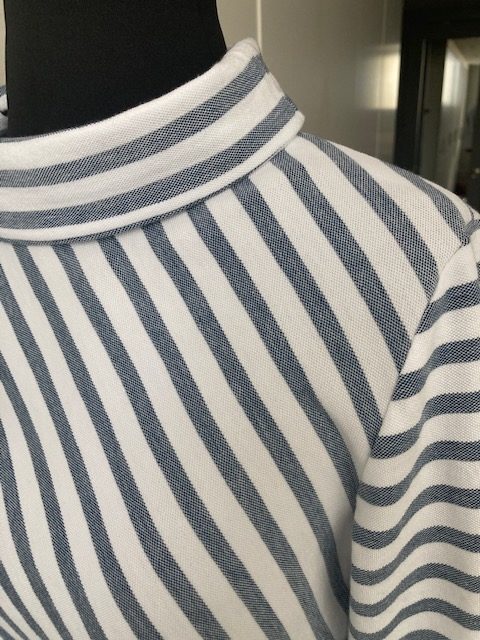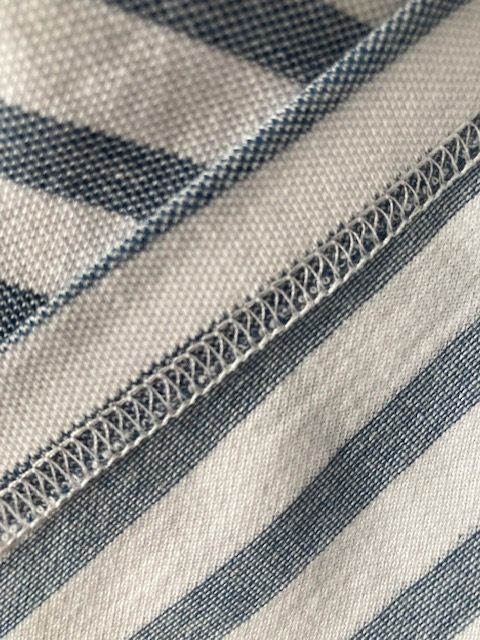
Who doesn’t love the timeless style of the traditional Breton-inspired shirt? Introduced initially as the uniform for navy seamen in northern France in 1858, the style has been copied and transformed throughout the years. The Breton stripes even inspired Coco Chanel’s 1917 nautical collection. Search online for Coco in a Breton shirt, and you’ll find fetching shots of the iconic fashion mogul wearing this style. Now in spring 2023, the style is just as relevant as ever.
I’ve always loved a Breton-inspired striped shirt, but does it always have to be that simple, crew-neck, long-sleeved, true-to-form style? Of course not! What about making this classic with a twist—literally and figuratively?
I was inspired this season by the new season’s striped piqué jersey (SKU-LD3409-007). I love a piqué knit, and the fabric content of this one—100% cotton—is ideal for the coming warmer months. I ordered it online and was not disappointed by its drape and soft hand. What about a new twist on an old style? Vogue patterns to the rescue!
Vogue pattern 1805 (SKU: V1805A) just begged to be created in this fabric. I loved the soft drape at the front of this Breton-inspired creation, and that tie at the neck would give me just the twist I was looking for. The sleeves, however, didn’t resonate with me, so I chose to use the three-quarter length, slim sleeves from the alternate view.

Before I started cutting and sewing, as always, I cut a 4 X 4-inch square of fabric and washed and dried it. The shrinkage was minimal, and the fabric looked great after the test, so I washed the entire length in preparation.
About the Pattern
Although I hesitate to do a pattern review here, I want to share some of my observations about this pattern that might help anyone who chooses to make this style.
First, it’s a pattern from the Vogue series they call “Today’s Fit,” designed by Sandra Betzina. It’s important to recognize this since the sizing system differs from other Vogue patterns. Rather than size 10, 14, 16 etc., the sizes are A, B, C and so on up to J. It’s important to check the body measurements to ensure you’re selecting the correct size. The other issue with these sizes is that they have chosen to include all of them in a single pattern. This means there are ten cutting lines, ten sets of markings and so on. Finding your particular lines and markings can be a challenge. Frankly, I think they could have done better by making two versions: A to E and F to J.
Another observation I’d like to share is to be sure you check the seam allowances carefully. Most seam allowances are 5/8-inch, but the neckline, including the collar and the entire tie, uses ¼-inch seam allowances. This size of a seam allowance is common for necklines, but most Vogue patterns don’t bother to use it. Just be careful.
Cutting and Sewing
Much of this pattern is designed to be cut in a single layer. I made sure I marked the grain lines boldly and the perpendicular line so I could use it when laying out the front in particular. If you’re working with stripes that go across the grain, you can use them for a grain line only if you have marked your cross grain on your fabric.

I used two types of marking methods for this pattern. I used disappearing ink markings for most, but I chose to use tailor’s tacks to align those pleats perfectly.
I used my sewing machine for the initial shoulder seams and pleats but then used a four-thread safety stitch on my serger-coverstitch machine for both the sleeve heads and the side and under-arm seams. Then it was time to hem.

I used fusible hem tape (the kind that clearly indicates you can sew over it—there are two different kinds, and I recommend being careful with this) to prepare the bottom and sleeve hems. Since this fabric is a jersey knit, it curls dramatically to the right side as jersey does. Stabilizing these 5/8-inch hems before sewing made the job much easier, and the hems didn’t stretch out. I used a two-needle cover stitch to finish the hems.

The style looks like it might be a lot of work for what is essentially a T-shirt, but I have to admit it was only a few hours’ worth of sewing. And so worth the effort!
Styling & Wearing
I was delighted with the outcome of the combination of this Vogue pattern and the piqué knit. The fabric is even soft enough for the folds of the pleating to fall nicely. How will I wear this one?

I’m looking forward to wearing it with white jeans as soon as the weather is warm enough to pull the jeans out of the summer closet. With my downtown life, I’ll wear it for walking in the city and even to brunch. I can see this on regular rotation!


I share sewing stories regularly on my blog, The GG Files, at www.gloriaglamont.com.